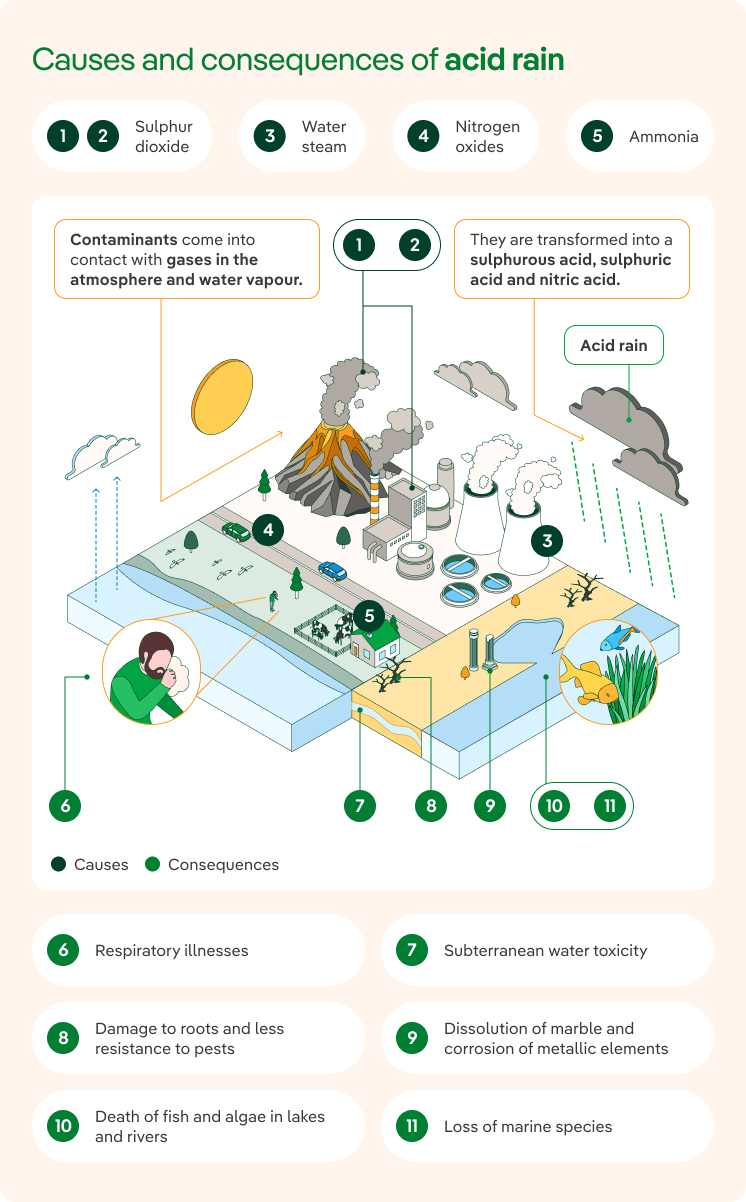What is acid rain
Acid rain, a true danger to living beings
Acid rain is one of the consequences of air pollution. Gases produced from the burning of fuels react with the oxygen in the air and water vapour, transforming into acids that fall onto the earth's surface as rain. This acidification of the earth and surface water has devastating effects on ecosystems and poses a serious danger to living beings.

Why does acid rain occur?
Volcanic eruptions, earthquakes, natural fires, lightning and some microbial processes release sulphur dioxide and nitrogen oxides into the atmosphere. However, it is human action that causes most sulphur dioxide emissions due to the burning of fuels in industry and power stations, as well as half of nitrogen oxide emissions due to gases produced by motor vehicles. Likewise, although to a lesser extent, intensive livestock farming produces ammonia from the decomposition of organic matter.
These three pollutants, which can be transported over long distances from where they originate, oxidise in contact with the atmosphere and result in the formation of sulphuric acid and nitric acid. These acids dissolve in water droplets in the clouds and fall on the earth's surface as acid rain, which can also occur in the form of snow or fog.


 SEE INFOGRAPHIC: Causes and consequences of acid rain [PDF] External link, opens in new window.
SEE INFOGRAPHIC: Causes and consequences of acid rain [PDF] External link, opens in new window.
Effects of acid rain
The pH of rain changes when combined with sulphuric acid and nitric acid, so when it falls onto the ground or water it alters their chemical characteristics and endangers the balance of the ecosystems. This is known as acidification of the environment, a phenomenon that has serious effects:
-
Oceans can lose biodiversity and productivity. The lowering of the pH of marine waters harms phytoplankton, a food source for different organisms and animals, which can modify the food chain and lead to the extinction of different marine species.
-
Inland waters are also acidifying at a very rapid rate, which is particularly worrying as although only 1% of the planet's water is fresh, 40% of fish live in it. This acidification increases the concentration of metal ions — mainly aluminium ions — which could lead to the death of many fish, amphibians and aquatic plants in acidified lakes. In addition, heavy metals are transported to underground waters, which become unsuitable for consumption.
-
In forests, the low pH level of the soil and the concentration of metals such as aluminium prevent vegetation from properly absorbing the water and nutrients it needs. This damages roots, slows growth and makes plants weaker and more vulnerable to diseases and pests.
-
Acid rain also affects artistic, historical and cultural heritage. In addition to corroding metallic elements of buildings and infrastructures, it deteriorates the external appearance of monuments. The greatest damage occurs to calcareous constructions, such as marble, which gradually dissolve due to the effect of acids and water.
How to avoid acid rain?
Since we are its main cause, the solution to the problem of the acidification of the environment is in the hands of humans: to mitigate acid rain, it is essential to reduce pollutant emissions. For this, there needs to be a commitment at government and corporate level to drive a series of measures:
- Filter and detoxify the water used by the factories before returning it to the rivers.
- Reduce the emission of pollutant gases by industry.
- Encourage the production and use of renewable energy instead of fossil fuels.
- Reduce the energy consumption of factories and companies.
- Promote innovation and new technologies aimed at optimising energy consumption and developing renewable energy.
- Plant trees to absorb polluted air.
- Make the population aware of the importance of reducing household energy consumption.
- Encourage the use of the electric vehicles and other non-polluting vehicles, such as bicycles.
Iberdrola group is fully aligned with this commitment to reduce the emission of polluting gases into the atmosphere. In this regard, it has proposed to have zero emissions in Europe by 2030 and to be carbon neutral globally by 2050.
Energy transition and decarbonisation




